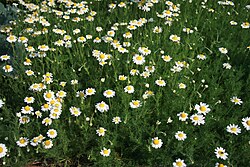Chamaemelum nobile: Difference between revisions
Jump to navigation
Jump to search
No edit summary |
|||
| Line 52: | Line 52: | ||
*[http://www.pfaf.org/user/Plant.aspx?LatinName=Chamaemelum+nobile Plants for a Future] | *[http://www.pfaf.org/user/Plant.aspx?LatinName=Chamaemelum+nobile Plants for a Future] | ||
*[http://www.botanical.com/botanical/mgmh/c/chammo49.html Grieve's Herbal] | *[http://www.botanical.com/botanical/mgmh/c/chammo49.html Grieve's Herbal] | ||
*[http://www.tela-botanica.org/bdtfx-nn-16476-synthese Tela Botanica] | |||
*[[:fr:Camomille (Cazin 1868)|Cazin 1868]] (camomille) | *[[:fr:Camomille (Cazin 1868)|Cazin 1868]] (camomille) | ||
Revision as of 14:40, 22 July 2014
Chamaemelum nobile (L.) All.
| Order | Asterales |
|---|---|
| Family | Compositae |
| Genus | Chamaemelum |
2n =
Origin : Europe
wild and cultivated
| English | {{{english}}} |
|---|---|
| French | {{{french}}} |
Popular names
- English: Roman chamomile
- French: camomille romaine
see general discussion on chamomile.
Biology
- Prostrate habit. The form with double flowers is propagated by cuttings.
- Leaves compound with filiform segments.
- Receptacle with paleas between the flowers.
Classification
Chamaemelum nobile (L.) All. (1785)
syn.:
- Anthemis nobilis L. (1753)
Cultivars
The most commonly cultivated forms have double flowers, with only white ligulate flowers.

History

Originating in Europe, this species has spread to North America and Argentina.
Uses
- Ornamental
- Human medicine
- Beverage
- Essential oil
- Food flavoring
